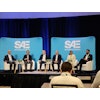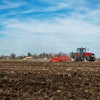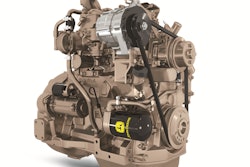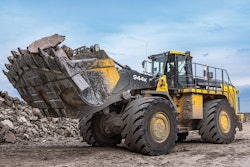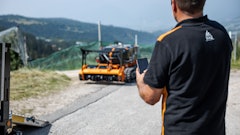
responses submitted by Darrin Treptow, Manager of Worldwide Marketing Support, John Deere Power Systems, and John Radke, Manager of Worldwide Customer Support, John Deere Power Systems
Diesel vs. Electric
Do you think there will always be a place for diesel powered equipment for heavy-duty applications? Why or why not?
Yes, I believe the diesel engine as we know it today still has a long life ahead. While the off-highway industry continues to grow and adapt, the demands remain the same. And to that point, a rugged market demands a product that can meet customers’ expectations in a variety of applications. Diesel engines offer the power density that’s required to meet the needs of off-highway applications in a way that other fuel and energy sources can’t currently match. However, the continued development and implementation of power electronics will influence future engine characteristics and requirements including, size, performance, load cycles, etc.
Today’s diesel engines are designed for durability and performance while meeting environmental compliance regulations. John Deere launched the PowerTech platform in 1996 to meet EPA and EU Tier 1/Stage 1 emissions regulations. We built on this off-highway engine platform to meet each subsequent emissions regulation. Because of this, John Deere is well-positioned to meet the power and durability needs of our customers while offering the latest technology to lower emissions while improving performance and fluid economy.
What would electric power sources have to achieve in order to replace the diesel engine for heavy-duty applications?
The cost, package size and weight of energy storage solutions to achieve the needed kilowatt-hours for electrification are hurdles to overcome, as well as working with the market to accept something new.
Components and systems for the off-road implementation of electrification are evolving as manufacturers are at different phases of adoption and development. For example, John Deere was an early adopter of electrification technology, as it introduced the 644K Hybrid Wheel Loader in 2013. However, off-highway electrification trends have always been first influenced by what’s happening on-highway simply because of the volume and investment that the on-highway industry can bring to a new technology development.
Keeping that in mind, on-highway electrification solutions may have different requirements than what is needed for off-highway applications, including load cycles and infrastructure support — the requirements and value propositions of which are so varied that developing a singular solution becomes very challenging. Because of this, there is an opportunity to create customized electrification solutions for individual market segments, resulting in a wide variety of solution architectures and associated components. This is what makes electrification very exciting right now.
One of the keys to success in the development of this emerging market is to account for the entire system solution. John Deere’s OEM electrification approach seeks to offer integrated solutions that address the interfaces between the electrical generator and/or motors, power electronics and mechanical interfaces. Because we have already completed the development work to manage these interfaces, the end-users can have confidence in the fact that all this new technology on their machines will simply work.
What do you think is the next step for emissions regulations after Tier 4 Final and Stage V?
The emissions world is ever-evolving. With our global experience meeting emissions tiers that we’ve gained since 2011, we are well-positioned to utilize combinations of these technology systems to meet regulations introduced globally.
We can also further emphasize leveraging developed technologies to optimize our product to best address market and customer needs. A recent example of this for John Deere was developing the new 13.6L engine. We took a “clean-sheet” design approach, and focused on delivering increased efficiency, installation flexibility and power in a more compact package.
How are you looking at engine system design and development for the future?
An area of focus for John Deere continues to be ease of integration, as it continues to be a critical need of our customers. To address this, we focus on improved packaging while offering increased power density. We have improved the integration of the sub-systems throughout the emissions journey. The EGR, fuel systems, air systems, and controls are integrated into the design up front to improve overall packaging as demonstrated by our new 13.6L engine. The 13.6L engine is approximately 18% smaller than its predecessor and weighs 10% less, due to an increased focus on machine integration.
Managing the Data Trend
Since the onset of Big Data several years ago, how has data become an integrated part of your design and development process?
Utilizing both in-house and field data is a key component to our design and verification processes. With the addition of sensors and connected components, we can leverage real-world data from our customers as well as our own application experience.
Insights from advanced analytics applied to that data are creating new opportunities; to optimize our equipment and solutions to deliver more value to our customers.
As far as what’s next for component testing, damage modeling is a key initiative for our product verification and validation team. That process would allow us to take field data to the next level.


